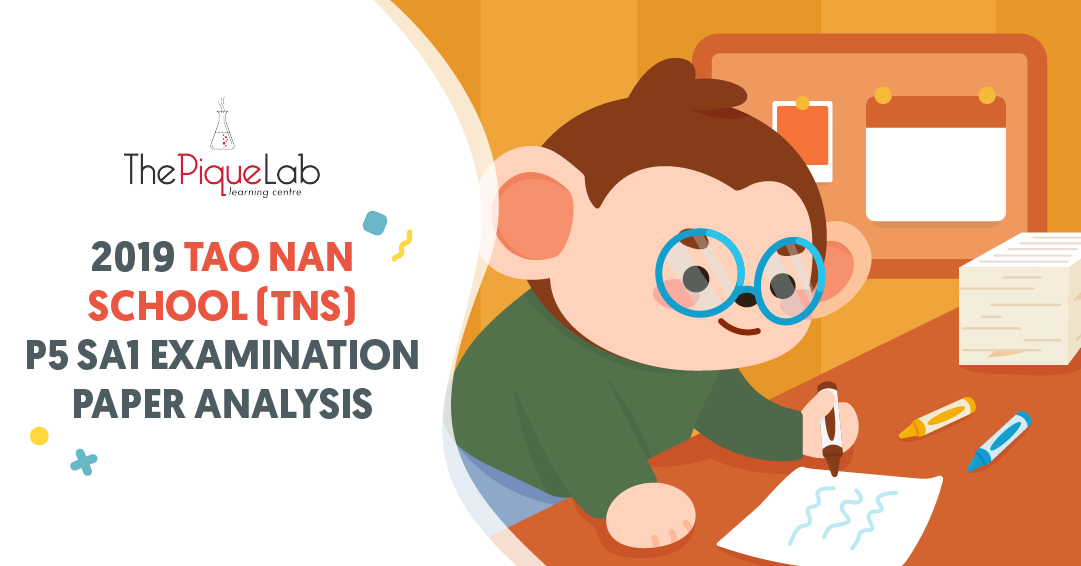Most examination questions tested on the topic of Reproduction are usually application questions that many students find challenging.
In today’s article, I will be analysing a past year examination question on the topic of Reproduction from the 2019 Tao Nan School (TNS) P5 SA1 Examination Paper. I will also be sharing other common questions that you can prepare beforehand to answer them accurately and quickly in your examinations.
You may also choose to watch the video here.
Read Also:
Let’s Get Started On This Question!

Source: Tao Nan School – 2019 P5 SA1 Examination Paper [Q32]
When faced with an anatomical diagram, we encourage you to label the different organs or parts of the system.

Out of all these labelled parts, the fallopian tube is discussed often because the fallopian tube is where fertilisation takes place. This is different from fertilisation in plants, which takes place at the ovary.
Many Reproduction questions will require you to find differences and similarities between human and plant reproduction. Although the location of fertilisation for human and plant reproduction is different, both humans and plants undergo sexual reproduction. This means that they require a male reproductive cell to fuse with the female reproductive cell.

Let’s Analyse Part (A)
“Name the process that takes place when the female egg cell fuses with the male reproductive cell.”
With that in mind, let’s discuss the ovary.
The human ovary produces and releases female reproductive cells called eggs. Once an egg is mature, it will be released into the fallopian tube to wait for the male reproductive cell called the sperm.
The sperm will swim towards it and once it reaches the egg, the sperm fuses with the egg in the process of fertilisation.
The fertilised egg will move down to the womb. The womb is the place where the fertilised egg is implanted and develops into a baby.
Once the baby has fully developed, it will be passed out of the female’s body through the vagina.
This is why the vagina is also known as the birth canal. It means that it is a passageway through which the baby can pass out from the mother’s body.
Suggested Answer For Part (A)
This process is fertilisation.
Let’s Analyse Part (B)
“Due to health reasons, a woman needs to have her part Y removed. Will she still be able to reproduce after that? Explain why.”

We can see that one of the woman’s ovaries is being removed.
Fortunately, the human body comes with two ovaries, so even with one damaged or removed, the other can still continue to produce and release mature eggs. These mature eggs are also capable of fusing with sperm in the process of fertilisation and implanting in the womb where the fertilised egg will develop into a healthy baby.
The same can be said for males. In the male reproductive system, there are two testes. If one is damaged or removed, the other will still produce and release sperm capable of fusing with the mature egg in the process of fertilisation.
Suggested Answer For Part (B)
Yes. Both parts X and Y are the ovaries. When part Y is removed, the woman still has part X to produce and release mature eggs, which can fuse with the sperm in the process of fertilisation. This allows the woman to still be able to reproduce after that.
Common Reproduction Questions
1a) Birth Control: Female Reproductive System
Birth control refers to how we can prevent the fertilised egg from being formed. In the context of this Primary school topic, this refers to various surgical means.
You are not required to know the names of these surgeries, but you need to understand the processes and purposes.
One method involves the female reproductive system. Cuts are made at both the fallopian tubes and the ends are tied up.

Alternatively, the tubes are clamped by a clip to block the passageway. Once the tube is blocked or severed, the sperm will no longer be able to travel through the tubes to reach the mature egg. If they are unable to meet, the egg will not be fertilised.
1b) Birth Control: Male Reproductive System
The other method involves the male reproductive system. Similar to the female reproductive system, the male reproductive system also has a pair of tubes called the sperm ducts.
Although it is not necessary for you to know its name, you are required to understand its function. This is where the sperm travel to reach the penis and then get released into the vagina.
By cutting or clamping the sperm duct, the sperm have no way to reach the penis and cannot be released, thus preventing fertilisation from taking place.

2) Biological Inheritance And Genetics
Occasionally, some examination papers may include a question on children and their genetics. For example, “Are children who share the same set of parents genetically identical?”.
The answer to this question depends on the context and most of the time, the question involves twins.
There are two different kinds of twins:
- Fraternal: Fraternal twins are conceived from two separate eggs and sperm in the same womb. Fraternal twins are not genetically identical.
- Identical: Identical twins share the same egg and sperm, and they are genetically identical.

3) Reproduction In Animals
Some Reproduction questions touch on animal reproduction rather than human reproduction. Such questions are application questions. For example, “Why do some animals lay many eggs at one time while others may give birth to just one young at a time?”.
4) Comparing Plant And Animal Reproductive Parts
As mentioned before, it is common for your teachers to test you on your understanding of different organs and reproductive parts by making you draw comparisons between plant and human reproductive organs and cells.
For example, the ovary of a human being is the equivalent of the ovary of a flower. The vagina is similar to the stigma as they both receive male reproductive cells, the sperm for humans and the pollen grains for plants. In the same vein, the anthers are the equivalent of the testes.

However, other plant parts don’t have any equivalents to human reproductive organs and are unique to their kind. Some examples include the styles, filaments, and petals.
Thus, it is important that you know all of these human reproductive organs and plant parts to make these comparisons.
Conclusion
As covered, the Plant Cycle is a culmination of different concepts across different plant-related topics learned over three years. You will need to be able to relate all these different concepts together to demonstrate your proficiency and understanding in your Science examinations.
Stay tuned for more articles! 🙂

If you like our methodology, we've some upcoming workshops:







